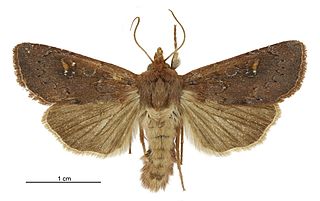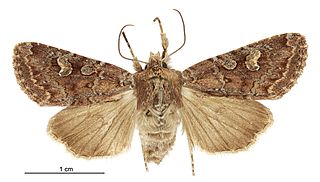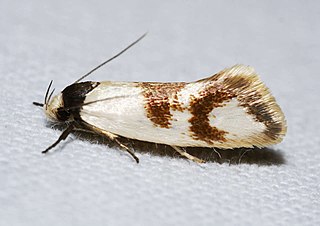
Maoricrambus is a genus of moths of the family Crambidae. It contains only one species, Maoricrambus oncobolus, which is endemic to New Zealand. This species is classified as Nationally Endangered by the Department of Conservation.
Batrachedra helarcha is a species of moth of the family Batrachedridae. It is found in Australia.
Acrocercops tripolis is a moth of the family Gracillariidae. It is known from Indonesia (Java).
Izatha apodoxa is a moth of the family Oecophoridae. It is endemic to New Zealand, where it is known from scattered localities in the southern North Island. This species is variable in appearance and comes in two forms, a grey form and a black and white form. In the grey form it is very similar in appearance to I. notodoxa and in the black and white form to I. katadiktya. At present the larvae and biology of this species is unknown.
Izatha manubriata is a moth of the family Oecophoridae. It is endemic to New Zealand, where it is known from the southern South Island only.

Batrachedra eucola is a species of moth in the family Batrachedridae. It is endemic to New Zealand and found both the North and South Islands. This species frequents scrubland habitat and is on the wing in January and February. B. eucola can be easily distinguished from its close relatives as it larger in size, has a pronounced palpi tuft and has full neuration of its hindwings.
Ancylometis trigonodes is a species of moth in the family Oecophoridae. It is known from Mauritius.

Ichneutica alopa is a moth of the family Noctuidae. It is endemic to New Zealand and is found in the central and southern parts of the North Island as well as in the South Island. It inhabits tussock grasslands and wetlands and can occur at ranges from the alpine zone down to almost sea-level. The life history of this species is unknown as are the host species of its larvae in the wild. Larvae of this species have been raised in captivity on Sphagnum moss as well as on species in the genus Raoulia. Adults of this species are on the wing from late January to April and are attracted to light and to sugar traps. I. alope can be confused with I. agorastis, I. micrastra or I. sapiens but the latter three species can be distinguished externally from I. alope through differences in size, forewing pattern and the antennae of the male of the species.

Chersadaula ochrogastra is a species of moth in the family Oecophoridae. This species is endemic to New Zealand. It is classified as "Data Deficient" by the Department of Conservation.

Pyrgotis eudorana is a species of moth of the family Tortricidae. It is endemic in New Zealand and has been observed in both the North and South Islands. However it is regarded as a rare insect. This species inhabits native forest. Larvae exclusively feed on Muehlenbeckia australis and adults are on the wing from November to April. Adults are attracted to light.
Ichneutica paraxysta is a moth of the family Noctuidae. It is endemic to New Zealand. This species is very similar in appearance to its close relative I. acontistis but as the range of the two species do not overlap this is unlikely to cause confusion. I. paraxysta is only found in the North Island at the subalpine zones in the Mount Taranaki region and at Mount Ruapehu. It prefers tussock grassland and shrubland habitat. The life history of this species is unknown as are the host species of its larvae however it has been hypothesised that the larval host plants are species in the genera of Poa and Festuca.

Ichneutica agorastis is a moth of the family Noctuidae. This species is endemic to New Zealand. This moth is similar in appearance to two other species in the genus but can be distinguished through the colour and size of its forewings. This species is found in the South Island and Stewart Island in open habitats in the subalpine zone. However in Southland I. agorastis can be found down to sea-level. Adult moths are on the wing between January and April. The life history and host species are unknown.

Asaphodes cosmodora is a species of moth in the family Geometridae. This species is endemic to New Zealand and has been observed in the South Island. The adults of this species are on the wing in January and February.

Antipterna trilicella is a species of moth in the family Oecophoridae, first described by Edward Meyrick in 1885 as Ocystola trilicella. It appears to be a moth endemic to Australia and confined to the east coast, occurring in Victoria, New South Wales and Queensland.

Antipterna euanthes is a species of moth in the family Oecophoridae, first described by Edward Meyrick in 1885 as Ocystola euanthes, with the female lectotype being found in the Wirrabara Forest, South Australia. It appears to be a moth endemic to Australia and in addition to South Australia is also found in Victoria, New South Wales, and Queensland.
Antipterna acrobaphes is a species of moth in the family Oecophoridae, first described by Edward Meyrick in 1885 as Ocystola acrobaphes. The holotype was collected in Sydney, New South Wales, in January 1878.
Antipterna diclethra is a species of moth in the family Oecophoridae, first described by Edward Meyrick in 1885 as Ocystola diclethra. Lectotypes for both Ocystola diclethra and Machaeretis niphoessa were both collected in greater Sydney, New South Wales.
Antipterna glacialis is a species of moth in the family Oecophoridae, first described by Edward Meyrick in 1885 as Ocystola glacialis. The holotype was collected at Mount Lofty, South Australia.
Antipterna monostropha is a species of moth in the family Oecophoridae, first described by Edward Meyrick in 1885 as Ocystola monostropha. The lectotype for Ocystola monostropha was collected at Blackheath, New South Wales.
Antipterna lithophanes is a species of moth in the family Oecophoridae, first described by Edward Meyrick in 1885 as Ocystola lithophanes. The lectotype for Ocystola lithophanes was collected at Deloraine, Tasmania. Holotypes for Alfred Jefferis Turner's synonyms were collected from Queensland and New South Wales.








